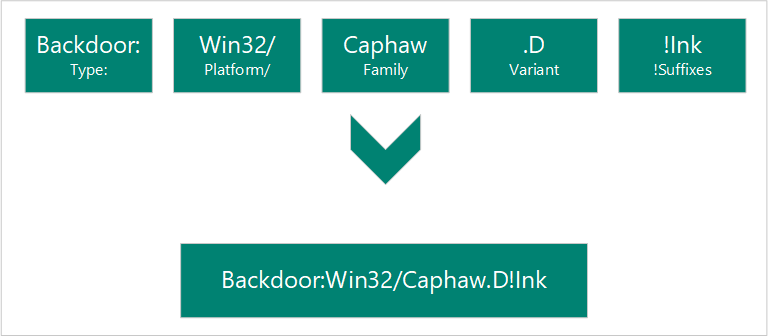Nomi di malware
Denotiamo il malware e il software indesiderato che rileviamo in base allo schema di denominazione del malware CARO (Computer Antivirus Research Organization). Lo schema usa il formato seguente:

Quando gli analisti ricercano una particolare minaccia, determinano il nome di ognuno dei componenti.
Tipo
Descrive cosa fa il malware sul computer. Worm, virus, trojan, backdoor e ransomware sono alcuni dei tipi più comuni di malware.
* Adware
* Backdoor
* Behavior
* BrowserModifier
* Constructor
* DDoS
* Exploit
* HackTool
* Joke
* Misleading
* MonitoringTool
* Program
* Personal Web Server (PWS)
* Ransom
* RemoteAccess
* Rogue
* SettingsModifier
* SoftwareBundler
* Spammer
* Spoofer
* Spyware
* Tool
* Trojan
* TrojanClicker
* TrojanDownloader
* TrojanNotifier
* TrojanProxy
* TrojanSpy
* VirTool
* Virus
* Worm
Piattaforme
Le piattaforme guidano il malware al sistema operativo compatibile ,ad esempio Windows, macOS e Android. Le indicazioni della piattaforma vengono usate anche per i linguaggi di programmazione e i formati di file.
Sistemi operativi
* AndroidOS: Android operating system
* DOS: MS-DOS platform
* EPOC: Psion devices
* FreeBSD: FreeBSD platform
* iOS: iPhone operating system
* Linux: Linux platform
* macOS: MAC 9.x platform or earlier
* macOS_X: macOS X or later
* OS2: OS2 platform
* Palm: Palm operating system
* Solaris: System V-based Unix platforms
* SunOS: Unix platforms 4.1.3 or lower
* SymbOS: Symbian operating system
* Unix: general Unix platforms
* Win16: Win16 (3.1) platform
* Win2K: Windows 2000 platform
* Win32: Windows 32-bit platform
* Win64: Windows 64-bit platform
* Win95: Windows 95, 98 and ME platforms
* Win98: Windows 98 platform only
* WinCE: Windows CE platform
* WinNT: WinNT
Linguaggi di scripting
* ABAP: Advanced Business Application Programming scripts
* ALisp: ALisp scripts
* AmiPro: AmiPro script
* ANSI: American National Standards Institute scripts
* AppleScript: compiled Apple scripts
* ASP: Active Server Pages scripts
* AutoIt: AutoIT scripts
* BAS: Basic scripts
* BAT: Basic scripts
* CorelScript: Corelscript scripts
* HTA: HTML Application scripts
* HTML: HTML Application scripts
* INF: Install scripts
* IRC: mIRC/pIRC scripts
* Java: Java binaries (classes)
* JS: JavaScript scripts
* LOGO: LOGO scripts
* MPB: MapBasic scripts
* MSH: Monad shell scripts
* MSIL: .NET intermediate language scripts
* Perl: Perl scripts
* PHP: Hypertext Preprocessor scripts
* Python: Python scripts
* SAP: SAP platform scripts
* SH: Shell scripts
* VBA: Visual Basic for Applications scripts
* VBS: Visual Basic scripts
* WinBAT: Winbatch scripts
* WinHlp: Windows Help scripts
* WinREG: Windows registry scripts
Macro
* A97M: Access 97, 2000, XP, 2003, 2007, and 2010 macros
* HE: macro scripting
* O97M: Office 97, 2000, XP, 2003, 2007, and 2010 macros - those that affect Word, Excel, and PowerPoint
* PP97M: PowerPoint 97, 2000, XP, 2003, 2007, and 2010 macros
* V5M: Visio5 macros
* W1M: Word1Macro
* W2M: Word2Macro
* W97M: Word 97, 2000, XP, 2003, 2007, and 2010 macros
* WM: Word 95 macros
* X97M: Excel 97, 2000, XP, 2003, 2007, and 2010 macros
* XF: Excel formulas
* XM: Excel 95 macros
Altri tipi di file
* ASX: XML metafile of Windows Media .asf files
* HC: HyperCard Apple scripts
* MIME: MIME packets
* Netware: Novell Netware files
* QT: Quicktime files
* SB: StarBasic (StarOffice XML) files
* SWF: Shockwave Flash files
* TSQL: MS SQL server files
* XML: XML files
Famiglia
Raggruppamento di malware in base a caratteristiche comuni, inclusa l'attribuzione agli stessi autori. I provider di software di sicurezza a volte usano nomi diversi per la stessa famiglia di malware.
Lettera variante
Usato in sequenza per ogni versione distinta di una famiglia di malware. Ad esempio, il rilevamento per la variante ".AF" sarebbe stato creato dopo il rilevamento per la variante ". AE".
Suffissi
Fornisce dettagli aggiuntivi sul malware, incluso il modo in cui viene usato come parte di una minaccia multicomponente. Nell'esempio precedente "!lnk" indica che il componente di minaccia è un file di collegamento usato da Trojan: Win32/Reveton.T.
* .dam: damaged malware
* .dll: Dynamic Link Library component of a malware
* .dr: dropper component of a malware
* .gen: malware that is detected using a generic signature
* .kit: virus constructor
* .ldr: loader component of a malware
* .pak: compressed malware
* .plugin: plug-in component
* .remnants: remnants of a virus
* .worm: worm component of that malware
* !bit: an internal category used to refer to some threats
* !cl: an internal category used to refer to some threats
* !dha: an internal category used to refer to some threats
* !pfn: an internal category used to refer to some threats
* !plock: an internal category used to refer to some threats
* !rfn: an internal category used to refer to some threats
* !rootkit: rootkit component of that malware
* @m: worm mailers
* @mm: mass mailer worm